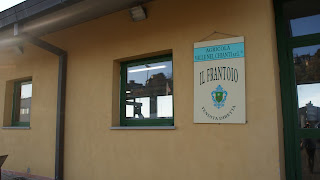Last Friday, tour guide and friend Anne Barbetti, photographer Carly and I ventured into the Chianti countryside. We had been invited to lunch at Mary Foreman's (see ending of the post "A Little Bit of England in Florence") and had meant to stop at the Montagliari wine estate. David Migliorini, Montagliari's owner, however, had to suddenly make a visit to the dentist that day, so we planned to tour a frantoio, an olive mill not far from our lunch venue.
Anne drove the winding road leading from Florence to the Chianti area, which produces superb wine and olive oil en route to Mary's farmhouse near Panzano. Carly in the back seat weakly protested about the curves, "everything is flat and in a straight line in Florida," she said, getting close to carsick looking out the window at the Chianti autumn scenery.
About 40 minutes from Florence, we turned left past Montagliari and went down a bumpy strada bianca (unpaved dirt road covered with a scattering of white gravel) to arrive at Mary's residence
Il Corneto.
Isn't this is what visitors dream of when they imagine a Chianti farmhouse? The day was overcast, as you can see by the light. Mary was waiting for us outside, and explained that she had taken temporary residence in the studio, as all the pipes and plumbing was in the process of being replaced in the main house. We found the studio charming (see below).
The painting is the work of Mary's friend Giannina (English, despite her name), who told us she had spent 10 years doing watercolors--financed by English sponsors--along the Tuscan stretch of the medieval pilgrim road la via Francigiana. Giannina explained to us that the via Francigiana linked Canterbury to Rome.
The table was laid with Italian ceramic dishes and English silverware in the spirit of biculturalism.
Pane toscano was toasted on the stove, and a small bowl of garlic cloves was passed around so that we could rub it on the crusty bread. Then newly-made olive oil was passed around to the complete the dish, called fettunta (oily slice) in Tuscany and known as the simplest type of bruschetta elsewhere.
While most of us drank Chianti wine, Carly accepted a glass of freshly-squeezed orange juice, made from Sicilian blood orange tarocco, which provided a startling contrast to the fettunta.
Traditionally, Tuscan residents and natives alike enjoy fettunta to savor the pungent taste of freshly-made olive oil.
After lunch, Anne decided to accompany us to the frantoio (olive mill). She and I (in the brown jacket) are in the photo to the left leaving Il Corneto. To the right is the Panzano olive mill we visited.
When asked about the 2011 olive harvest, the mill's director, Carlo, explained,
"because of scarce rainfall," (this is why I named the blog this past spring Beautiful Florence as the city was at its best in the unceasing sunshine), olive production in Tuscany was down by at least 25%."
"But the remaining olives that were harvested were healthy, untouched (at least in the hills of Chianti) by parasites or disease, so the quality of this year's olive oil is good to superior," he said. Because of the decrease in harvested olives--which in Chianti are of the morellino, frantoio and leccino
varieties, Carly, Anne and I caught the tail end of the milling process, which begins at the end of October and normally extends to mid-December or to just before Christmas.
The entire olive mill was permeated with the scent of new oil,
olio nuovo.
Families and small producers from Greve, Panzano, Radda, Gaiole and Castellina come here to press their olives, Carlo explained. When I asked if the olives were stone-ground--macinata a pietra--
he laughed at my romantic notion. "No, we use the modern centrifuge system here," he said.
The olives delivered by customers go up a chute,
to the production room, where the leaves and debris are eliminated.
The olives are then washed...
...and ground to a paste and spun in a centrifuge to separate the water from the oil.
The olio nuovo comes out of a sprout into a metal can, which is transferred to the bottling area.
At lunch, however, Mary told us that the olives picked on the Corneto property had been pressed and bottled at the frantoio that we planned to visit. Hers (see below) is
pure, unfiltered extra virgin,
unlike the green transparent boutique olive oils che si trovono in giro (that can be seen around).
When we asked Carlo about stone-ground cold press olive oil, he was amused at our romantic notion. "This is something from the past," he said. "The centrifuge system is universal."
This may be, but we saw a grinding stone--in disuse--at the Panzano frantoio.
Back at Mary's, we found the same stone on the ground--now a decorative element expressing the ancient soul of Chianti.
Nearby, there was an unwelcome suitor of Mary's cat patiently waiting outside,
Lovelorn, he rubbed himself against the doorstep....
See the olive leaves on the ground? Such is the poetry of
an olive oil day in Chianti.
Reporting live
-- Rosanna















No comments:
Post a Comment